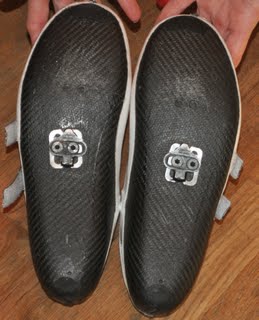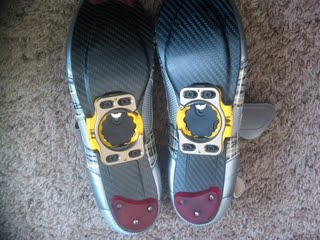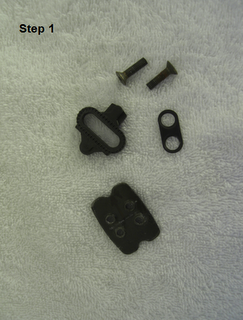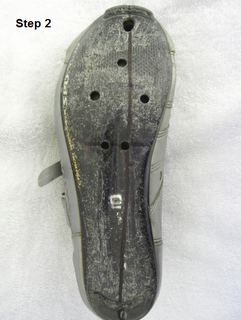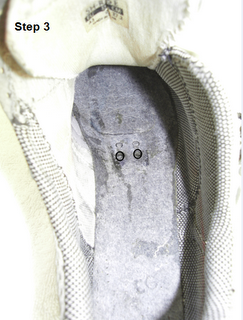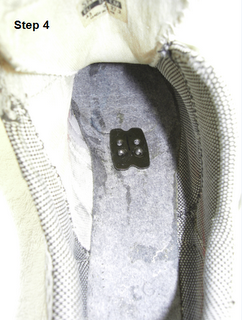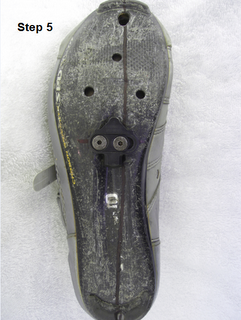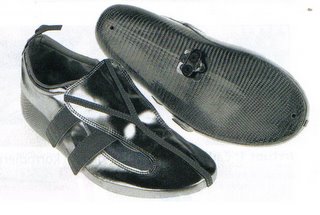More Custom Midsole Cleats
Here's another picture of a reader's custom midsole cleat position. The athlete is Ramon Alarcon and the shoes are Specialized. His comments follow.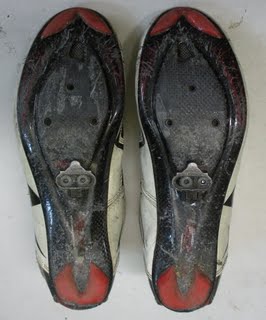 Attached are a couple of pictures of a pair of 2007 Specialized S-Works Road Shoes that I modified to work with the midsole cleat position. In one of the pictures, you can see that because of the shape of the sole, I had to build up the platform to provide a load bearing surface for the cleat. I used a slow setting epoxy to build up this platform below the cleat. So far, I've put about 5k miles on the shoes with no problems.
Attached are a couple of pictures of a pair of 2007 Specialized S-Works Road Shoes that I modified to work with the midsole cleat position. In one of the pictures, you can see that because of the shape of the sole, I had to build up the platform to provide a load bearing surface for the cleat. I used a slow setting epoxy to build up this platform below the cleat. So far, I've put about 5k miles on the shoes with no problems.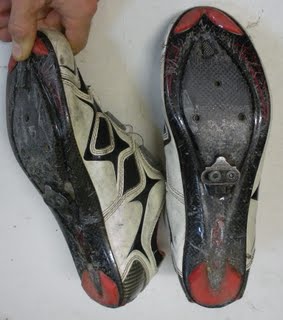 The reason I chose to try the mid-sole position is due to a medical condition. In 2008, I was diagnosed with Exercise Induced Arterial Endofibrosis. For those who don't know about it, it's a narrowing of an artery located in the hip caused by repeated motion under load. The artery in question supplies blood to the leg. Basically, the millions of times your hip flexes while cycling can cause this condition under certain circumstances. This limitation in blood flow was not a problem during moderate training, but it was causing cramping in the quads and possibly calves during intense efforts during races. When I first read about the mid-sole position, I figured, hey, if my blood flow is limited, why would I direct any to supply the calves that aren't needed to move the bicycle forward. Since switching to the mid-sole position, I have had no cramping problems in races. I still notice a drop in power due to the blood flow limitation, but it seems like the mid-sole position has minimized this. I have been able to reach about 96% of the FTP I had before the diagnosis.
The reason I chose to try the mid-sole position is due to a medical condition. In 2008, I was diagnosed with Exercise Induced Arterial Endofibrosis. For those who don't know about it, it's a narrowing of an artery located in the hip caused by repeated motion under load. The artery in question supplies blood to the leg. Basically, the millions of times your hip flexes while cycling can cause this condition under certain circumstances. This limitation in blood flow was not a problem during moderate training, but it was causing cramping in the quads and possibly calves during intense efforts during races. When I first read about the mid-sole position, I figured, hey, if my blood flow is limited, why would I direct any to supply the calves that aren't needed to move the bicycle forward. Since switching to the mid-sole position, I have had no cramping problems in races. I still notice a drop in power due to the blood flow limitation, but it seems like the mid-sole position has minimized this. I have been able to reach about 96% of the FTP I had before the diagnosis.
One final note. I have my EIAE monitored through regular testing. It has been stable for a year. For the sake of further investigation, my doctor had me participate in a test to measure Popliteal Artery Entrapment. It turns out that, even though I'm not a runner, I have that too. A fairly large percentage of the population may have this. It seems to me that the mid-sole cleat position would provide a benefit to cyclists, especially those who also run, and are thus more prone to developing this condition.
Labels: cleat position, midsole
